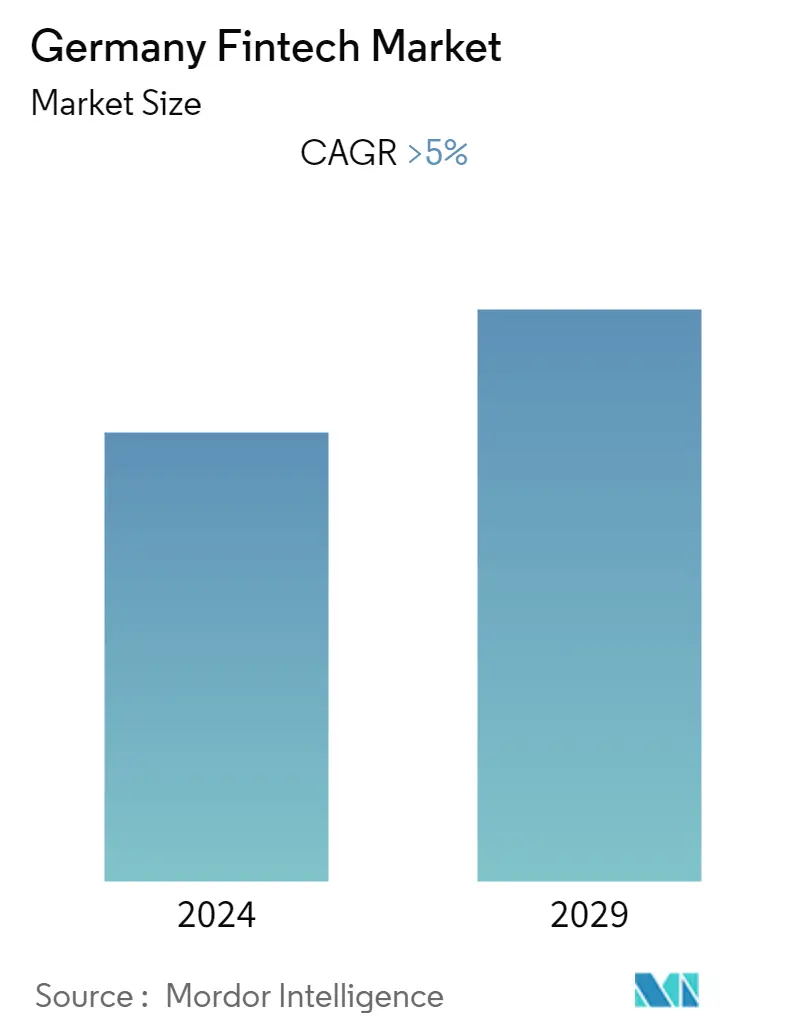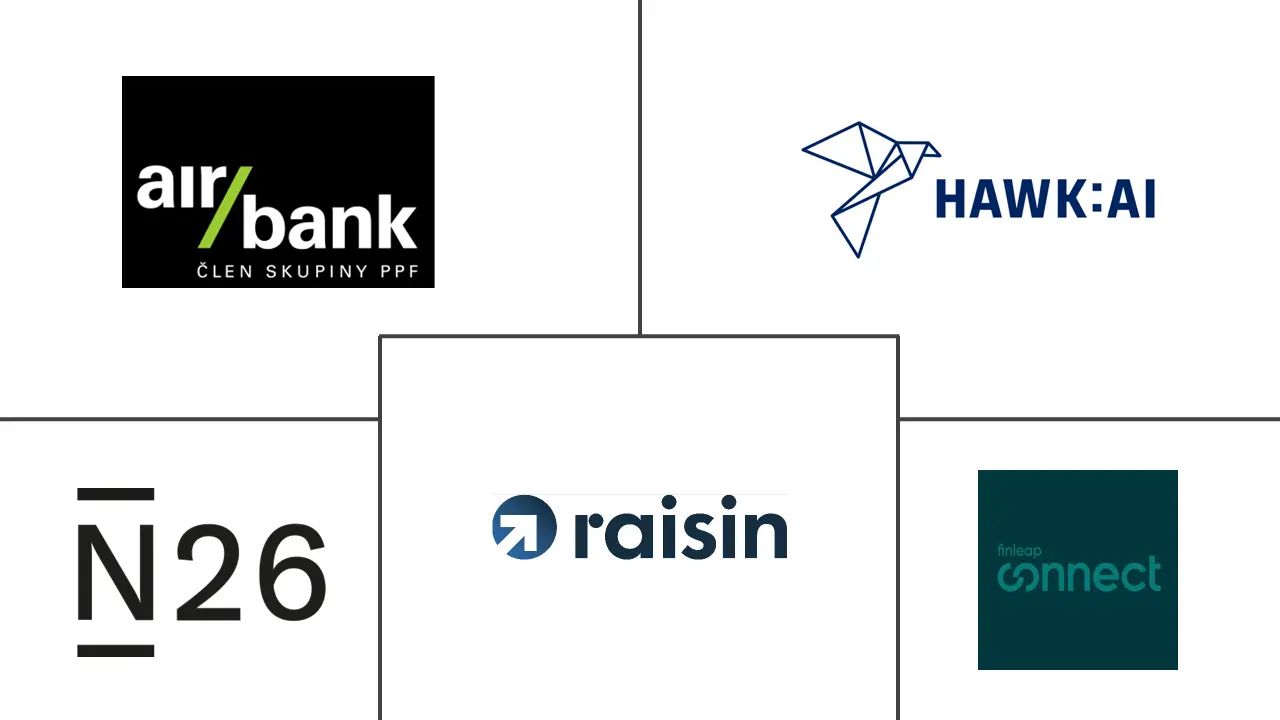Market Size of Germany Fintech Industry

| Study Period | 2019 - 2029 |
| Base Year For Estimation | 2023 |
| Forecast Data Period | 2024 - 2029 |
| Historical Data Period | 2019 - 2022 |
| CAGR | > 5.00 % |
| Market Concentration | Medium |
Major Players
*Disclaimer: Major Players sorted in no particular order |
Fintech in Germany Market Analysis
The Germany Fintech market is expected to register a CAGR of 5% in the forecast period.
Fintech adoption rates are growing around the world. According to EY, 64 percent of global consumers use Fintech, with a rate as high as 87 percent in China and India. Fintech adoption in Germany almost doubled during 2017-18, with German use now at the same level as the global average. German banking licenses are strictly regulated by the Federal Financial Supervisory Authority, Bafin. Fintech founders have reported difficulties while applying for a banking license and navigating the stringent regulations to enter the marketplace.
The COVID-19 pandemic and the corresponding health measures changed customer behavior immensely. As people sought to make less physical contact, the demand for contactless paying services grew strongly in 2020. According to Germany Trade and Invest, 43% of Germans changed their payment method to cashless options to avoid human contact. Even small retail shops that in the past only accepted cash switched to contactless payments for hygiene reasons. However, only 8% of German consumers preferred mobile payment options to classic card payments.
Nevertheless, in 2020, because of a struggling economy due to the impact of Covid-19, investment in Fintech's worldwide went down. According to a KPMG report on global Fintech, the total investment from private equity, M&A, and venture capital, was around USD 150 billion in 2019, whereas in 2020, only USD 26 billion were invested globally. As the international economy is recovering, investments are expected to rise back to the level of 2019.
The innovative technologies and disruptive business models are removing market entry and expansion barriers, with German Fintech looking to expand beyond Germany and international Fintech also entering the German market. Almost three-quarters of foreign Fintechs are active in the Banking and Lending, Payments, and Enabling Processes & Technology segments.
Fintech in Germany Industry Segmentation
Fintech is one of the most widely demanded products as people adopt urbanization. A complete background analysis of the Germany Fintech Market includes an assessment of the economy, a market overview, market size estimation for critical segments, emerging trends in the market, market dynamics, and critical company profiles covered in the report. The Germany Fintech Market is segmented by service proposition (Digital Payments (Digital Commerce & Mobile POS Payments), digital capital raising (Crowdfunding, Crowdinvesting, & Crowdlending), digital investment (Robo-Advisors & Neobrokers), Neobanking, digital assets (Cryptocurrencies & NFT), and others). The report offers market size and forecasts in value (USD million) for all the above segments.
| By Service proposition | |||||
| |||||
| |||||
| |||||
| NeoBanking | |||||
|
Germany Fintech Market Size Summary
The Fintech market in Germany is experiencing significant growth, driven by increasing adoption rates and the emergence of innovative technologies. The sector is characterized by a robust regulatory environment, with the Federal Financial Supervisory Authority (Bafin) overseeing banking licenses, which presents challenges for new entrants. The COVID-19 pandemic accelerated the shift towards contactless payment methods, as consumers sought to minimize physical interactions. This shift has led to a surge in demand for cashless payment solutions, although traditional card payments remain more popular among German consumers. Despite a global decline in Fintech investments during the pandemic, the market is poised for recovery as the international economy stabilizes, with Germany attracting substantial investment in its banking sector.
Germany stands as a leading European hub for Fintech, with a vibrant startup ecosystem driving innovation. The market is fragmented, with numerous companies competing for market share by adopting advanced technologies and enhancing their service offerings. Key players such as AirBank, Hawk: AI, Finleap Connect, Raisin DS, and N26 are actively expanding their operations to capture a larger share of the market. The influx of investment and the entry of international Fintech firms into the German market are expected to further bolster the sector's growth. As the market continues to evolve, the focus on technological advancement and the adoption of new payment solutions will play a crucial role in shaping the future of Fintech in Germany.
Germany Fintech Market Size - Table of Contents
-
1. MARKET INSIGHTS AND DYNAMICS
-
1.1 Market Overview
-
1.2 Market Drivers
-
1.3 Market Restraints
-
1.4 Value Chain / Supply Chain Analysis
-
1.5 Industry Attractiveness - Porter's Five Forces Analysis
-
1.5.1 Threat of New Entrants
-
1.5.2 Bargaining Power of Buyers/Consumers
-
1.5.3 Bargaining Power of Suppliers
-
1.5.4 Threat of Substitute Products
-
1.5.5 Intensity of Competitive Rivalry
-
-
1.6 Insights on Latest Trends and Technological Innovations in the Industry
-
1.7 Impact of COVID-19 on market
-
-
2. MARKET SEGMENTATION
-
2.1 By Service proposition
-
2.1.1 Digital Payments
-
2.1.1.1 Digital Commerce
-
2.1.1.2 Mobile POS Payments
-
-
2.1.2 Digital Capital Raising
-
2.1.2.1 Crowdfunding
-
2.1.2.2 Crowdinvesting
-
2.1.2.3 Crowdlending
-
-
2.1.3 Digital Investment
-
2.1.3.1 Robo-Advisors
-
2.1.3.2 Neobrokers
-
-
2.1.4 NeoBanking
-
2.1.5 Digital Assets
-
2.1.5.1 Cryptocurrencies
-
2.1.5.2 NFT
-
-
-
Germany Fintech Market Size FAQs
What is the current Germany Fintech Market size?
The Germany Fintech Market is projected to register a CAGR of greater than 5% during the forecast period (2024-2029)
Who are the key players in Germany Fintech Market?
AirBank, Hawk:AI, Finleap Connect, Raisin DS and N26 are the major companies operating in the Germany Fintech Market.

